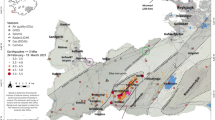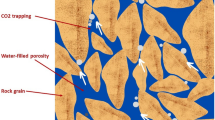Abstract
In the framework of the German R&D programme CLEAN (CO2 Large-Scale Enhanced Gas Recovery in the Altmark Natural Gas Field), the geological structure of an area encompassing the Altensalzwedel sub-field and its surrounding was analysed in detail. A 3-D model was developed that contains the major geological formations and their general lithology including the natural gas reservoir (in the Permian Rotliegend), the immediate cap rock (Permian Zechstein) of the reservoir and its overburden. Based on this geological model, a 3-D steady-state thermal model was generated as part of a shared earth model. The parameterisation of the geological model layers with thermal rock properties is based on laboratory and well-log data. The model shows temperature changes in dependence of geological structure and of different rock thermal conductivity. The calculated surface heat flow is high (>80 mW m−2) for most of the area, which is in accordance to measured surface heat flow. Temperature on top of the Rotliegend reservoir is variable ranging from 110 to 150 °C. The quantification of temperature changes versus depth as well as laterally in the reservoir are valuable input data for modelling the dynamic processes of CO2 injection within CLEAN.







Similar content being viewed by others
References
Bachmann GH, Ehling B-C, Eichner R, Schwab M (2008) Geologie von Sachsen-Anhalt. Schweizerbart, Stuttgart
Balling N, Kristiansen JI, Breiner N, Poulsen KD, Rasmussen R, Saxov S (1981) Geothermal measurements and subsurface temperature modelling in Denmark. Techn Ber Geoskrifter No. 16: Dep of Geol Aarhus Univ, ISSN: 0105-824X
Bayer U, Scheck M, Koehler M (1997) Modeling of the 3D thermal field in the Northeast German Basin. Geol Rundsch 86(2):241–251
Benek R, Kramer W, McCann T, Scheck M, Negendank J, Korich D, Huebscher H-D, Bayer U (1996) Permocarboniferous magmatism of the Northeast German Basin. Tectonophysics 266:379–404
Benox D, Ludwig AO, Schulze W, Schwab G, Hartmann H, Knebel G, Januszewski I (1997) Struktur und Entwicklung mesozoischer Störungszonen in der Südwest-Altmark. Hallesches Jahrb Geowiss B19:83–114
Cacace M, Kaiser BO, Lewerenz B, Scheck-Wenderoth M (2010) Geothermal energy in sedimentary basins: What we can learn from regional numerical models. Chem der Erde 70(S3):33–46
Čermák V, Huckenholz H-G, Rybach L, Schmid R, Schopper JR, Schuch M, Stöffler D, Wohlenber J (1982) Physical properties of rocks. In: Augenheister G (ed) Landolt-Börnstein, vol 1a. Springer, Berlin
Clauser C (2003) Numerical simulation of reactive flow in hot aquifers—Shemat and Processing Shemat. Springer, Berlin
Deming D (1989) Application of bottom-hole temperature corrections in geothermal studies. Geophysics 18:775–786
DSK (2002) German Stratigraphic Commission (ed) Stratigraphic Table of Germany 2002, Potsdam. ISBN:3-00-010197-7
Effenberger H (2000) Dampferzeugung. Springer, Berlin
El-Sharkawy AA, Rashed JH, Zaghloui MS, Ghoniem MH (1984) Study of thermal properties of polycrystalline KCl, KBr and HI in the temperature range 300 to 600 K. Phys Stat Sol a 85:429–434
Feldrappe H, Obst K, Wolfgramm M (2008) Die mesozoischen Sandsteinaquifere des Norddeutschen Beckens und ihr Potential für die geothermische Nutzung. Z Geol Wiss 36(4–5):199–222
Förster A (2001) Analysis of temperature data in the Northeast German Basin: continuous logs versus bottom-hole temperatures. Petroleum Geosci 7:241–254
Fuchs S, Förster A (2010) Rock thermal conductivity of Mesozoic geothermal aquifers in the Northeast German Basin. Chem der Erde 70(S3):13–22
Hamdan IN, Clarke BG (2010) Determination of thermal conductivity of coarse and fine sand soils. In: Proc World Geotherm Congr, vol 7, Bali, Indonesia, 25–29 April 2010
Haszeldine RS (2009) Carbon capture and storage: how green can black be? Science 325:1647–1652. doi:10.1126/science.1172246
Hjuler ML, Fabricius IL (2009) Engineering properties of chalk related to diagenetic variations of Upper Cretaceous onshore and offshore chalk in the North Sea area. J Petroleum Sci Eng 68:151–170
Hölting B (1996) Hydrogeologie. Enke, Stuttgart
Hurtig E, Rockel W (1992) Federal Republic of Germany Eastern Federal States. In: Hurtig E, Čermák V, Haenel R, Zui V (eds) Geothermal atlas of Europe. Hermann Haack Verlagsgesellschaft mbH, Gotha, pp 38–40
Jensen P (1990) Analysis of the temperature field around salt diapirs. Geothermics 19(3):273–283
Jessop A (1990) Comparison of industrial and high-resolution thermal data in sedimentary basin. Pure Appl Geophys 133:251–267
Kühn M, Bartels J, Iffland J (2002) Predicting reservoir property trends under heat exploitation: interaction between flow, heat transfer, transport, and chemical reactions in a deep aquifer at Stralsund, Germany. Geothermics 31:725–749
Kühn M, Förster A, Großmann J, Meyer R, Reinicke K, Schäfer D, Wendel H (2011) CLEAN: preparing for a CO2-based enhanced gas recovery in a depleted gas field in Germany. Energy Procedia 4:5520–5526. doi:10.1016/j.egypro.2011.02.538
Kühn M, Tesmer M, Pilz P, Meyer R, Reinicke K, Förster A, Kolditz O, Schäfers D, CLEAN Partners (2012) CLEAN: CO2 Large‐Scale Enhanced Gas Recovery in the Altmark Natural Gas Field (Germany): Project overview. Environ Earth Sci. doi:10.1007/s12665-012-1714-z
Kukkonen I, Jokinen J, Seipold U (1999) Temperature and pressure dependencies of thermal transport properties of rocks: implications for uncertainties in thermal lithosphere models and new laboratory measurements of high-grade rocks in the Central Fennoscandian Shield. Surv Geophys 20:33–59
LAGB (2011) Tektonische Übersichtskarte C3130 Salzwedel. Landesamt für Geologie und Bergwesen Sachsen-Anhalt (Geo Surv of Saxony-Anhalt). http://webs.idu.de/lagb/lagb-default.asp?thm=tek400&tk=C3130. Accessed 10 Nov 2011
LBEG (2010) Erdöl und Erdgas in der Bundesrepublik Deutschland 2009. Landesamt für Bergbau, Energie und Geologie Niedersachsen (Geo Surv of Lower Saxony), Hannover
Lorenz J (1971) Beitrag zum Zusammenhang von Geothermie, Geochemie und Hydrodynamik im Rotliegenden des Gebietes Salzwedel-Marnitz sowie NE-Mecklenburgs. Bergakademie Freiberg (unpublished report)
Lotz B (2004) Neubewertung des rezenten Wärmestroms im Nordostdeutschen Becken. Sci Tech Rep, GeoForschungsZentrum Potsdam, STR Rep 04/04: ISSN: 1610-0956
Magri F, Bayer U, Jahnke C, Clausnitzer V, Diersch H, Fuhrman J, Moeller P, Pekdeger A, Tesmer M, Voigt H (2005) Fluid-dynamics driving saline water in the North East German Basin. Int J Earth Sci 94(5):1056–1069
Mottaghy D, Pechnig R (2009) Numerische 3-D Modelle zur Temperaturvorhersage und Reservoirsimulation. BBR Fachmagazin für Brunnen- und Leitungsbau 10:44–51
Müller EP (1994) Development of oil and gas exploration in the eastern part of Germany. In: Popescu BM (ed) Hydrocarbons of Eastern Central Europe. Springer, Heidelberg, pp 119–146
Noack V, Cherubini Y, Scheck-Wenderoth M, Lewerenz B, Höding T, Simon A, Moeck I (2010) Assessment of the present-day thermal field (NE German Basin)—inferences from 3D modeling. Chem der Erde 70:47–62
Noack V, Scheck-Wenderoth M, Cacace M (2012) Sensitivity of 3D thermal models to the choice of boundary conditions and thermal properties: a case study for the area of Brandenburg (NE German Basin). Environ Earth Sci. doi:10.1007/s12665-012-1614-2
Norden B, Förster A (2006) Thermal conductivity and radiogenic heat production of sedimentary and magmatic rocks in the Northeast German Basin. AAPG Bull 90(6):939–962
Norden B, Förster A, Balling N (2008) Heat flow and lithospheric thermal regime in the Northeast German Basin. Tectonophysics 460:215–229
Ondrak R, Wenderoth F, Scheck M, Bayer U (1998) Integrated geothermal modeling on different scales in the Northeast German basin. Geol Rundsch 87:32–42
Otto R (2010) Bestimmung von Wärmeleitfähigkeiten. Abstract, 70. Jahrestagung der Dtsch Geophysikalischen Ges March 2010, Bochum
Pechnig R, Arnold J, Jorand R, Koch A, Clauser C (2009) Ergebnisse einer integrierten Analyse von Labor- und Bohrlochmessdaten an Lockersedimenten der Niederrheinischen Bucht und Festgesteinen des Rheinischen Schiefergebirges. In: Proceedings 5th NRW-Geothermiekonf Bochum November 2009
Popov YA, Pribnow DFC, Sass JH, Williams CF, Burkhardt H (1999) Characterization of rock thermal conductivity by high resolution optical scanning. Geothermics 28:253–276
Pudlo D, Reitenbach V, Albrecht D, Ganzer L, Gernert U, Wienand J, Kohlhepp B, Gaupp R (2012): The impact of diagenetic fluid‐rock reactions on Rotliegend sandstone composition and petrophysical properties (Altmark area, central Germany). Environ Earth Sci. doi:10.1007/s12665-012-1723-y
Radzinski KH (1996) Erdgeschichtlicher Rückblick, Sachsen-Anhalt. In: Das Geologische Landesamt—Tätigkeitsbericht 1993 bis 1995, Geo Surv Halle, pp 11–18
Rückheim J, Voigtländer G, Stein-Khokhlov M (2005) The technical and economic challenge of “mature gas fields”: the giant Altmark Field, a German example. SPE 94406, SPE/EAGE annual conference Madrid, pp 659–662
Scheibe R, Seidel K, Vormbaum M, Hoffmann N (2005) Magnetic and gravity modelling of the crystalline basement in the North German Basin. Z dt Ges Geowiss 156:291–298
Schön J (1996) Physical properties of rocks: fundamentals and principles of petrophysics. In: Helbig K, Teitel S (eds) Handb Geophy Explor, Sect. 1, 18
Speece M, Bowen T, Folcik J, Polack H (1985) Analysis of temperatures in sedimentary basins: the Michigan Basin. Geophysics 50:1318–1334
Stottmeister L, von Poblozki B (1999) Die geologische Entwicklung der Altmark—eine Übersicht. Mitt Geol Sachsen-Anhalt 5:45–72
Stottmeister L, von Poblozki B, Reichenbach W (2008) Altmark-Fläming-Scholle. In: Bachmann GH, Ehling B-C, Eichner R, Schwab M (eds) Geologie von Sachsen-Anhalt. Schweizerbart, Stuttgart, pp 348–369
Trusheim F (1957) Über Halokinese und ihre Bedeutung für die strukturelle Entwicklung Norddeutschlands. Z Dtsch Geol Ges 109:111–151
TU München (ed) (2010) Bavarian online material information system. http://www.werkstoffe.de. Accessed 15 Nov 2010
UEIS (2010) Berlin Digital Environmental Atlas. Urban and environmental information system (UEIS). Department for Urban Development, Berlin. http://www.stadtentwicklung.berlin.de/umwelt/umweltatlas/edua_index.shtml. Accessed 16 Nov 2010
VDI (2000) VDI 4640—thermal use of the underground, Part 1 & 2.VDI Man Energy Techn, Düsseldorf
Vedova BD, Vecellio C, Bellani S, Tinivella U (2008) Thermal modelling of the Larderello geothermal field (Tuscany, Italy). Int J Earth Sci (Geol Rundsch) 97:317–332. doi:10.1007/s00531-007-0249-0
Wolfgramm M, Rauppach K, Seibt P (2008) Reservoir-geological characterization of Mesozoic sandstones in the North German Basin by petrophysical and petrographical data. Z Geol Wiss 36(4–5):249–265
Ziegler PA (1990) Geological atlas of Western and Central Europe. Shell Internationale Petroleum Maatschappij B.V., New York, pp 1–239
Zoth G, Haenel R (1988) Thermal conductivity. In: Haenel R, Rybach L, Stegena L (eds) Handbook of terrestrial heat-flow density determination. Kluwer Academic Publishers, Norwell, pp 449–453
Acknowledgments
This study is part of the joint research project CLEAN, sponsored by the German Federal Ministry of Education and Research (BMBF) within the framework of the geoscientific research and development programme “GEOTECHNOLOGIEN”. This work is publication no. GEOTECH-1952. The authors would like to thank all partners of the CLEAN project for fruitful discussions. The manuscript benefitted from valuable comments of the editorial board and one anonymous reviewer.
Author information
Authors and Affiliations
Corresponding author
Rights and permissions
About this article
Cite this article
Norden, B., Förster, A., Behrends, K. et al. Geological 3-D model of the larger Altensalzwedel area, Germany, for temperature prognosis and reservoir simulation. Environ Earth Sci 67, 511–526 (2012). https://doi.org/10.1007/s12665-012-1709-9
Received:
Accepted:
Published:
Issue Date:
DOI: https://doi.org/10.1007/s12665-012-1709-9




